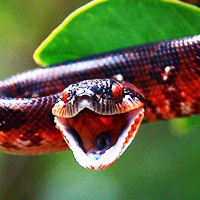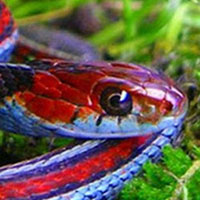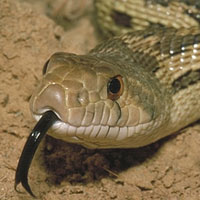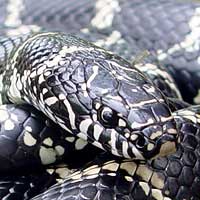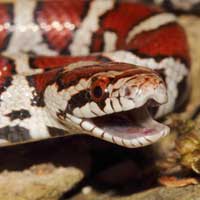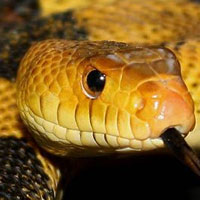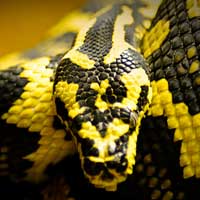Arizona Mountain Kingsnake: A Comprehensive Guide to This Stunning Reptile
The scientific name of the Arizona Mountain Kingsnake is Lampropeltis pyromelana. It belongs to the Colubridae family, which is the largest family of snakes and includes many non-venomous and mildly venomous species.
Scientific Name: Lampropeltis pyromelana
Snake Family: Colubridae
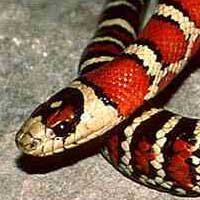
Introduction to the Arizona Mountain Kingsnake
The Arizona Mountain Kingsnake (Lampropeltis pyromelana) is a strikingly colorful and non-venomous snake native to the southwestern United States. Known for its vibrant red, black, and white bands, this snake is often mistaken for the venomous coral snake, though it is completely harmless. Its manageable size and gentle temperament make it a favorite among reptile enthusiasts.
Where Does the Arizona Mountain Kingsnake Live?
The Arizona Mountain Kingsnake thrives in rugged and rocky terrains, particularly in mountainous regions. Its range spans across Arizona, New Mexico, and parts of northern Mexico, where it can be found at elevations ranging from 4,000 to 9,000 feet.
Preferred Habitat Features:
- Rocky outcrops and slopes
- Wooded areas with ample ground cover
- Desert edges with boulders
- Riparian zones near streams
| Region | Habitat Type | Key Features |
|---|---|---|
| Arizona | Rocky mountain slopes | High elevation, rocky terrain |
| New Mexico | Wooded areas | Forest cover and ground debris |
| Northern Mexico | Desert margins | Scattered rocks and shrubs |
What Does the Arizona Mountain Kingsnake Eat?
The Arizona Mountain Kingsnake is a carnivorous predator, with a diet that reflects its opportunistic feeding habits. It primarily preys on small animals it can overpower and swallow whole.
Common Diet:
- Rodents such as mice
- Birds and their eggs
- Lizards
- Other snakes, including venomous species
In captivity, a diet of pre-killed or frozen-thawed rodents is recommended for safety and convenience. Juvenile snakes should be fed every 5-7 days, while adults can be fed every 10-14 days.
Behavior and Temperament of the Arizona Mountain Kingsnake
The Arizona Mountain Kingsnake is known for its shy yet curious behavior. While it is generally non-aggressive, it may exhibit defensive postures when threatened.
Key Behavioral Traits:
- Non-aggressive and reclusive
- Active during the day, especially in cooler months
- Exhibits mimicry by mimicking venomous coral snakes
- Adaptable to rocky and wooded environments
With regular and gentle handling, these snakes become docile and comfortable with human interaction, making them an excellent choice for reptile keepers.
Health and Lifespan of the Arizona Mountain Kingsnake
Arizona Mountain Kingsnakes are hardy and long-lived when properly cared for in captivity. They can live up to 20 years with proper husbandry and diet.
Common Health Concerns:
- Respiratory infections from improper humidity
- Parasites, especially in wild-caught specimens
- Shedding issues due to low humidity
To ensure their health, maintain a temperature gradient of 75-85°F, with a basking spot of 90°F, and provide fresh water for hydration and soaking. Regular veterinary check-ups are also recommended.
Reproductive Traits of the Arizona Mountain Kingsnake
The Arizona Mountain Kingsnake is oviparous, meaning it lays eggs. Mating typically occurs in the spring, followed by egg-laying in early summer.
Reproductive Details:
- Mating season: Spring
- Clutch size: 5-12 eggs
- Incubation period: 60-70 days
- Hatchlings are independent and self-sufficient at birth
In captivity, simulating seasonal changes in light and temperature can encourage breeding. A secure nesting area should be provided for egg deposition.
How to Handle and Care for the Arizona Mountain Kingsnake
Caring for the Arizona Mountain Kingsnake involves creating an environment that closely mimics its natural habitat and providing consistent, gentle handling.
Handling and Care Tips:
- Handle regularly to build trust and reduce stress
- Provide an enclosure with plenty of hiding spots and climbing branches
- Maintain a suitable temperature gradient and proper humidity
- Offer a diet that meets their nutritional needs
With proper care and attention, the Arizona Mountain Kingsnake can thrive in captivity, providing years of enjoyment and fascination for reptile enthusiasts.
Other Snakes In This Species
 Albino California Kingsnake
Albino California Kingsnake Arizona Mountain Kingsnake
Arizona Mountain Kingsnake Black Kingsnake
Black Kingsnake Brooks Kingsnake
Brooks Kingsnake California Kingsnake
California Kingsnake Desert Kingsnake
Desert Kingsnake Dot-Dash California Kingsnake
Dot-Dash California Kingsnake Durango Mountain Kingsnake
Durango Mountain Kingsnake Eastern Kingsnake
Eastern Kingsnake Florida Kingsnake
Florida Kingsnake Florida Mole Kingsnake
Florida Mole Kingsnake Goins Kingsnake
Goins Kingsnake Gray Banded Kingsnake
Gray Banded Kingsnake Mexican Black Kingsnake
Mexican Black Kingsnake Mole Kingsnake
Mole Kingsnake Prairie Kingsnake
Prairie Kingsnake Ruthvens Kingsnake
Ruthvens Kingsnake Scarlet Kingsnake
Scarlet Kingsnake Speckled Kingsnake
Speckled Kingsnake Utah Mountain Kingsnake
Utah Mountain Kingsnake Variable Kingsnake
Variable Kingsnake
